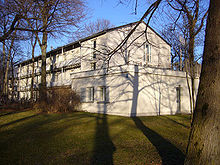Biederstein residence hall
The dormitory at Biederstein is a student residence in Munich . It is administered by the Munich Student Union . The dormitory is known for its carnival parties , which are attended by around 1000 Munich students and alumni every year.
The dormitory at Biederstein is located on Biedersteiner Strasse, close to the English Garden . The Dietlindenstraße underground station on the U 6 line is a five-minute walk away, and Münchner Freiheit about ten minutes. Biederstein Castle stood on the premises of the dormitory until 1934 .
Cultural life
Art and culture have played a prominent role at the dormitory at Biederstein since the 1960s. The student residence has been inhabited by students from the nearby Academy of Fine Arts in Munich since it was founded and has a lively cultural life. In 2010 the art competition "Art in the Cellar", initiated by the students, took place, which was sponsored by the cultural department of the city of Munich .
The Biederstein Carnival, which has been taking place annually since 1966, is the highlight of cultural life. The largest student carnival in Bavaria has more than 1000 visitors every year. Both the basement carnival (house 1 and 2) and the atrium carnival (house 3 and 4) are organized by the residents. Parts of the episode “The Chinese Method” of the crime film series Tatort were shot in 1991 at the Biederstein Carnival.
history
For a long time, the dormitory at Biederstein was considered Munich's “last commune”. Even today it is characterized by the close contact between the residents who live there. The dormitory was the nucleus of the Munich student unrest of the 1968 movement . During this time, Uschi Obermaier also lived in the dormitory on Biederstein. In the 1970s, the students fought for the right to name themselves in order to be able to independently select new roommates. The aim was to achieve the greatest possible self-administration . In 2009 the self-naming right was withdrawn again against the considerable resistance of the residents.
architecture
The dormitory consists of five individual monuments, some of which are interconnected. The complex is an important testimony to the early post-war Munich architecture and is therefore a listed building .
It was built between 1952 and 1956 by the Munich architects Otto and Harald Roth , making it one of the oldest dormitories in Munich. The construction of the dormitory for 300 students was supported by grants from the McCloy -Fonds and from ERP funds financed and is now owned by the Munich Student Union .
The dormitory was built on the park-like grounds of the former Biederstein Castle . The former castle gate has been reconstructed directly in front of the dormitory. The dormitory consists of two staggered buildings with a gable roof , which can be attributed to simple, conservative post-war architecture. The atrium house built later with arcades, on the other hand, already shows clearly modern features.
In 1981 the building was renovated by the Landeswohnungs- und Städtebauesellschaft, with new windows and balcony parapets being installed. In 2009/2010 the entire facility was completely renovated by the architects ffc architects gmbh . Due to changes in the floor plan, there are now 168 student spaces, 33 of which are single apartments with their own kitchenette and sanitary facilities.
In December 2011 the Munich Student Union A. d. Ö. R. honored as the client together with the architects from the ffc architekten gmbh office with the Munich Facade Prize for the renovated facade of house no.
literature
- https://www.merkur.de/lokales/muenchen/stadt-muenchen/biedersteiner-keller-neustart-einer-legende-1123880.html
- http://www.sueddeutsche.de/muenchen/studentenleben-in-muenchen-biedersteiner-auf-den-barrikaden-1.709404
- http://www.muenchen.de/veranstaltungen/orte/143787.html ( Memento from October 19, 2011 in the Internet Archive )
- Student housing estate Munich-Biederstein. In: Builder. 6, 1954, pp. 354-357.
- The Munich-Biederstein student housing estate. In: The construction newspaper. 3, 1957, pp. 85ff.
- Biederstein residence hall . In: Munich and its buildings. 1984, p. 343.
- Biederstein student residence. In: Winfried Nerdinger: Architecture Guide Munich. Reimer, pp. 142-143.
- Biederstein residence hall. In: Winfried Nerdinger: Architecture of the child prodigies. Awakening and displacement in Bavaria 1945–1960. Pustet, Munich 2005.
Web links
- Website of the Biederstein dormitory
- https://www.merkur.de/lokales/muenchen/stadt-muenchen/biedersteiner-keller-neustart-einer-legende-1123880.html
- Julia Häglsperger: Biedersteiner on the barricades , Süddeutsche Zeitung , September 11, 2008
- Website of the architects' association ffc architekten gmbh responsible for the renovation and renovation, http://ffc-architekten.de
- Refurbishment and renovation of the Munich student dormitory in Biedersteinerstraße, http://www.bayerische-staatszeitung.de/ Bayerische Staatszeitung , July 23, 2010, section "Building"
Coordinates: 48 ° 9 ′ 56 " N , 11 ° 35 ′ 45" E

